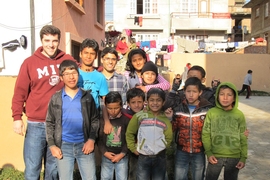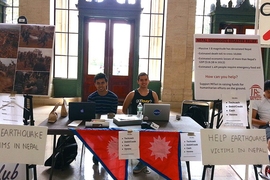On April 25, a magnitude 7.8 earthquake struck Nepal, killing more than 9,000, injuring more than 23,000, and leaving tens of thousands lacking food, shelter, and water. Aftershocks continue to afflict the nation, complicating efforts to rebuild.
With a sense of urgency and purpose, the MIT Nepali Students’ Association (MITeri) launched a fundraising campaign to support the immediate relief and recovery needs in the hardest-hit regions in Nepal — and, with the MIT Media Lab, hosted a Hack-for-Nepal Buildathon to identify opportunities for action for members of the MIT community.
Following the students’ lead, Chancellor Cynthia Barnhart asked Professor Jeffrey Ravel, head of the History Section; MITeri’s Bigyan Bista, a PhD student in biology; and Aaron Weinberger, assistant director for Institute Affairs, to coordinate efforts that bring the Institute’s strengths to bear on the country’s recovery. Ravel, Bista, and Weinberger have worked since April to understand Nepal’s greatest areas of need and to identify expertise across campus that might be leveraged to meet those needs.
In early June, the three MIT representatives joined peers at Harvard University and Tufts University in a meeting with Arjun Karki, Nepal’s ambassador to the United States, to discuss opportunities for institutional engagement in Nepal’s relief and reconstruction. Since then, they have established strong working relationships with leadership at universities, hospitals, and non-governmental organizations (NGOs) across Nepal.
Conversations with these stakeholders have yielded an understanding of need in three primary areas:
- urban policy and design, especially with regard to buildings equipped to withstand seismic activity;
- health care technologies; and
- water, sanitation, and hygiene.
A number of projects that draw on MIT’s strengths in these areas have begun to take shape.
For instance, Susan Murcott, a research affiliate in the Department of Urban Studies and Planning, is working with the Environment and Public Health Organization, a Nepali NGO, to disseminate rapid diagnostic kits she has developed for water quality testing.
Staff at the Abdul Latif Jameel Poverty Action Lab (J-PAL) are exploring the potential for researchers to partner with Dhulikhel Hospital to evaluate health outcomes of a health insurance intervention, as well as nutritional interventions in a longitudinal cardiovascular study.
Faculty in MIT’s Department of Earth, Atmospheric and Planetary Sciences and at the Nepal Academy of Science and Technology have discussed enlisting graduate students or postdocs to analyze seismological data collected following the earthquake and inform policymaking at local and national levels.
Through MIT Sloan Action Learning, the Institute hopes to send students to Nepal in the spring to work on sanitation-focused projects. And the MIT International Science and Technology Initiatives (MISTI), which had begun conversations about launching a Nepal program before the earthquake, is again considering ways to pair MIT students and faculty with internships and teaching programs in the country.
Ravel, Bista, and Weinberger have engaged faculty in the School of Engineering and the School of Architecture and Planning to discuss ways to assist in rebuilding Bungamati, an ancient township destroyed in the earthquake. In concert with UN-Habitat, faculty have expressed an interest in lending their expertise to the rebuilding effort and to using Bungamati as part of their students’ coursework or thesis projects.
The team is also exploring ways to assist Ram Rijal ’12, a native of Nepal who returned home after graduation to build MIT-inspired magnet schools. Rijal founded Bloom Nepal, a STEM-focused K-12 school whose curriculum includes courses from edX and Khan Academy. Bloom Nepal’s buildings and classrooms were destroyed in the earthquake, and two of the school’s janitors were killed.
“In actions and words, Ram represents the best of MIT,” Ravel says. “He has dedicated himself to creating educational opportunities for those most in need. We are committed to getting Bloom Nepal up and running again.”
MIT-India, which connects MIT students and faculty with research and industry in India, has fundraised on behalf of Bloom Nepal, generating donations from staff, students, faculty, and alumni in India.
Anyone interested in joining MIT in the Nepal response is encouraged to email nepal-recovery@mit.edu. MIT is also accepting donations to support efforts to aid the people of Nepal while creating meaningful research and learning opportunities for Institute faculty and students.








